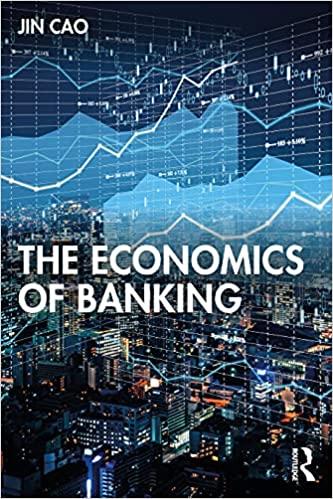Consider a banking sector with a finite number (N) limited liability banks that may operate over an
Question:
Consider a banking sector with a finite number \(N\) limited liability banks that may operate over an infinite discrete time horizon, \(T \rightarrow+\infty\). In each period, a representative bank \(i\) offers an interest rate on deposits of \(r_{i}\) in competition with other banks which offer
depositors interest rates \(\mathbf{r}_{-i}\). The total volume of deposits mobilized by the bank is \(D\left(r_{i}, \mathbf{r}_{-i}\right)\), with the volume of deposits increasing in the bank's own interest rate and decreasing in the competitors' rate, i.e., \(\frac{\partial D}{\partial r_{i}}>0\) and \(\frac{\partial D}{\partial r_{j}}<0, \forall j eq i\). Depositors have full deposit insurance, so the volume of deposits depends only on the interest rates offered.
After liabilities have been raised in the beginning of each period, the bank allocates its assets on either of two assets available: the prudent asset, with a return \(\alpha\), and the gambling asset, with a return of \(\gamma\) with probability \(\theta\) and 0 with probability \(1-\theta\). The prudent asset has higher expected return, \(\alpha>\theta \gamma\), but if the gamble succeeds, the bank earns higher private return, \(\gamma>\alpha\). When the gamble fails, the bank will lose its license of banking from the next period onward. Banks' discount factor is \(0<\delta<1\).
The bank's liabilities include both the deposits it collects and its own capital \(k\), which is expressed as a percentage of the deposits mobilized so that the total assets invested equal \((1+k) D\left(r_{i}, \mathbf{r}_{-i}\right)\). The bank's owners have also an alternative use of their capital that ensures a return equal to \(ho\). This implies that the opportunity cost of capital is \(ho\). The prudent asset ensures per-period profit \[\pi_{p}\left(r_{i}, \mathbf{r}_{-i}, k\right) \equiv m_{p}\left(r_{i}, k\right) D\left(r_{i}, \mathbf{r}_{-i}\right) .\]
When the bank gambles, the per-period profit is \[\pi_{G}\left(r_{i}, \mathbf{r}_{-i}, k\right) \equiv m_{G}\left(r_{i}, k\right) D\left(r_{i}, \mathbf{r}_{-i}\right) .\] \(m_{P}\left(r_{i}, k\right)\) is the effective profit margin earned on each unit of deposit if the bank chooses the prudent asset, while \(m_{G}\left(r_{i}, k\right)\) is the effective profit margin earned on each unit of deposit if the bank chooses the gambling asset.
(a) Compute \(m_{P}\left(r_{i}, k\right)\) and \(m_{G}\left(r_{i}, k\right)\) in an unregulated market in which banks are free to choose any level of \(k\). Each period can be divided into 3 stages:
Stage 1 Banks decide simultaneously their interest rates;
Stage 2 Each bank decides its own capital level;
Stage 3 Each bank decides whether to invest in the prudent asset or in the gambling asset.
The no-gambling condition under which only prudent assets are preferred under such settings has the form \(r \leq \hat{r}(k)\) (i.e., the threshold interest rate \(\hat{r}\) is a function of \(k\) ).
(b) Compute \(\hat{r}(k)\) under symmetric equilibrium in which all the banks choose the prudent asset and set the same interest rate \(r_{P}\). Show that the first order condition requires \(m_{P}\left(r_{P}, k\right)=\frac{D\left(r_{P}, \mathbf{r}_{P}\right)}{\frac{\partial D\left(r_{P}, \mathbf{r}_{P}\right)}{\partial r_{i}}}\), and the equilibrium interest rate can be written as \(r_{P}=f(\alpha, ho, k, \epsilon)\), in which \(\epsilon\) is the elasticity of deposit demand \(D\left(r_{P}, \mathbf{r}_{P}\right)\) with respect to interest rate \(r_{P}\).
(c) Compute \(f(\alpha, ho, k, \epsilon)\).
(d) If \(ho>\alpha\), what is the optimal \(k\) for the bank? Keep \(ho>\alpha\). Suppose now a regulation is introduced, requiring a bank to invest an amount of own capital equal no less than a share \(k^{R}\) of its total deposits mobilized.
(e) What is the effect of an increase in \(k^{R}\) on \(r_{P}\) and on \(\hat{r}\) ? Are there values of \(\delta\) for which \(\frac{\delta \hat{r}}{\delta k}<0\) ?
(f) Assume now that \(\hat{r}(k)\) is increasing in \(k\). Draw \(r_{P}\) and \(\hat{r}\) as a function of \(k\).
Let \(\underline{k}\) be defined by the equation \(r_{P}(\underline{k})=\hat{r}(\underline{k})\). Consider two alternative policies, both sufficient to ensure that banks choose the prudent investment:
Policy 1 Impose \(k^{R}>k\);
Policy 2 A cap on the interest rate that requires banks to offer no higher than \(r_{P}\left(k^{R}\right)\), together with a capital requirement of \(k_{0}\), which satisfies \(\hat{r}\left(k_{0}\right)=r_{P}\left(k^{R}\right)\).
(g) If policy 1 is chosen, show where \(k_{0}\) lies in the graph drawn for question (f). Which of the two policies is optimal for the regulator?
Step by Step Answer:





